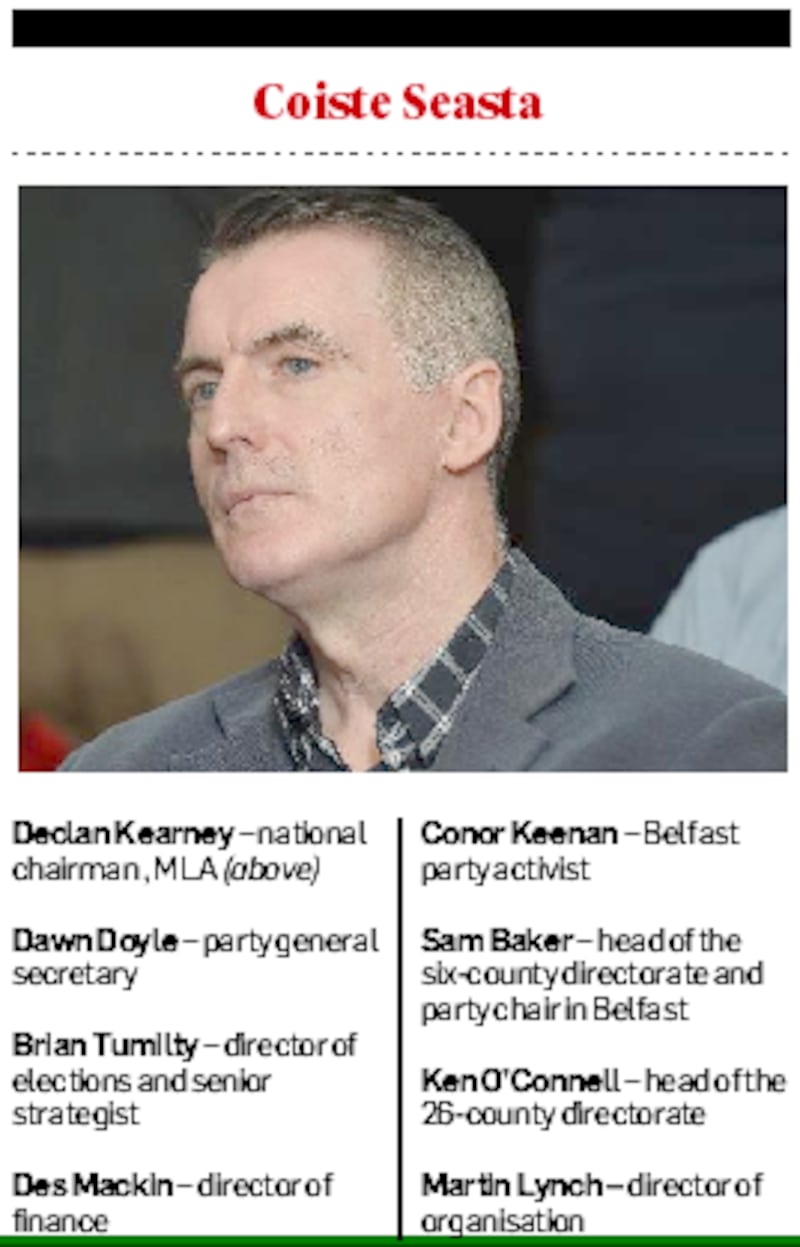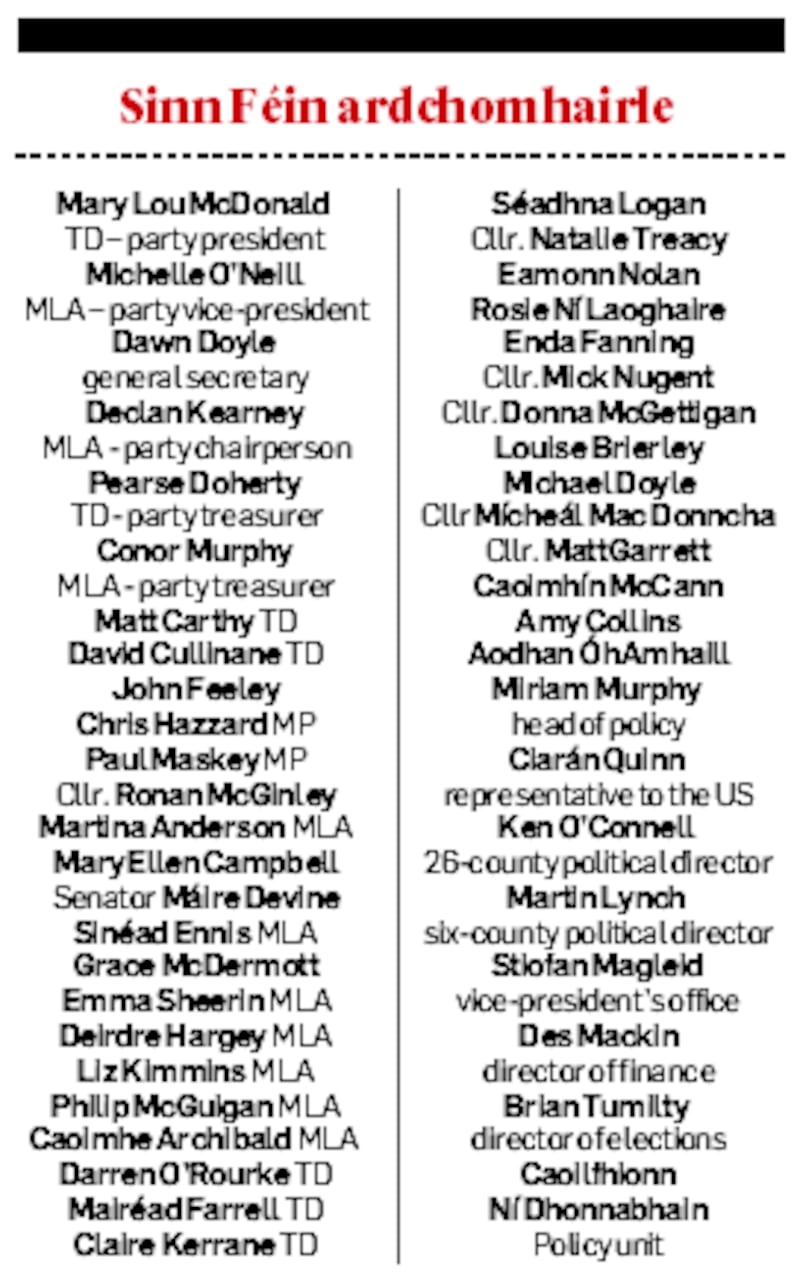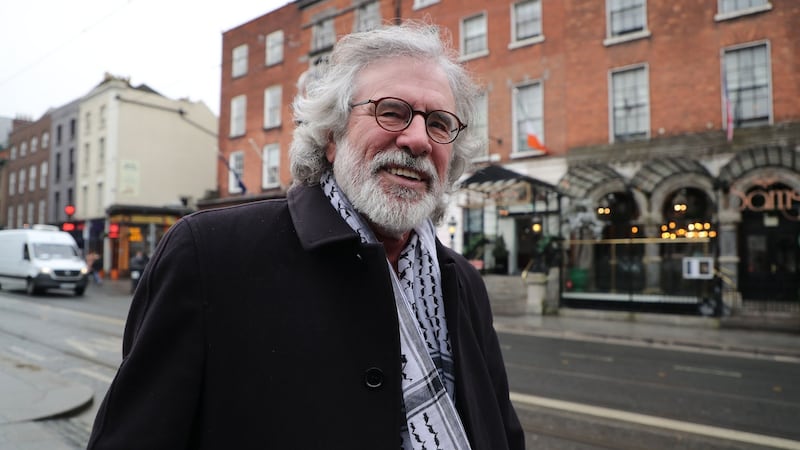Fianna Fáil leader Micheál Martin is correct when he says that Sinn Féin is "not a normal, democratic party", Sinn Féin's director of finance has told The Irish Times.
Martin has said that Sinn Féin’s elected representatives are not in control of the party, and that decisions are made by “shadowy figures” and “unelected officials”.
However, what Micheál Martin sees as a problem, the party’s long-term director of finance, Des Mackin, sees as an advantage. Sinn Féin does not want its elected representatives controlling the party, he said.
“We don’t want a parliamentary party running the organisation,” the senior party officer said. “We want to stay a party of activists. It’s a totally different model. There’s nothing mysterious about it.”
Mackin has been the party's director of finance for years and, prior to that, was joint party treasurer with the veteran republican, the late Joe Cahill. Mackin was convicted of IRA membership in the 1970s.
Three former Sinn Féin elected representatives also told The Irish Times that Martin was correct when he said the party is not controlled by its politicians.
Speaking off the record, the three politicians all said separately that Sinn Féin was a tightly controlled organisation where unelected officials sought to tell elected representatives what to do.
One of them said IRA veterans have the greatest influence within the party. "There are no paper walls hiding people," the politician said. "It's not a case of IRA figures in a smoky room in Belfast. They are on the ardchomhairle."
The Coiste Seasta
The three former Sinn Féin politicians said separately that the party’s standing committee, the Coiste Seasta, is a key body in the running of the party. There are currently eight people on the committee, only one of whom is an elected representative. Five of the eight are from Belfast.
Sinn Féin’s ultimate ruling body is its ardchomhairle, but it is a large body, sometimes with more than 50 members, and meets approximately 10 times a year. The smaller Coiste Seasta, which meets every fortnight, has the power of the ardchomhairle when the latter is not sitting, and runs the party on a day-to-day basis.
All the party’s national departments report to the ardchomhairle through the Coiste Seasta, according to the Sinn Féin constitution. The committee approves all payments out of party funds that are above €250.
The current membership of the Coiste Seasta is: Sinn Féin's national chairman Declan Kearney, MLA; party general-secretary Dawn Doyle; director of elections and senior strategist Brian Tumilty; director of finance Des Mackin; Belfast party activist Conor Keenan; head of the "six-county" directorate and party chair in Belfast Sam Baker; head of the "26-county" directorate Ken O'Connell; and director of organisation Martin Lynch.
Three of the members of the committee have IRA convictions.
Mackin, whose family was driven out of their Belfast homes twice in the 1960s, was jailed in the early 1970s for being an IRA member. In the early 1980s he resisted extradition to Northern Ireland, from the US, to face charges of attempted murder arising from the shooting of an undercover British soldier in Belfast, arguing that the 1978 shooting incident between the solidiers and some IRA members was part of a political conflict.

Deported at his request to Dublin, no effort was made by the UK authorities to deport him from there. Since the Provisional IRA ceasefire it has been UK policy that it is not in the public interest to arrest him when he travels in Northern Ireland.
Lynch, from Belfast, was a senior figure in the Provisional IRA when it was pursuing its campaign of violence. He was jailed in 1982 for being in possession of a Soviet-made rocket launcher, rocket-propelled grenades, and firearms.
In 2011, the then deputy leader of the DUP Peter Robinson named Lynch in the House of Commons as being the IRA’s “adjutant general” on its “headquarters” staff.
A former driver for Gerry Adams and the late Martin McGuinness, Lynch – along with O'Connell and Adams – is on the party's government formation team formed since the general election.
Tumilty was mentioned in a 2011 Police Service of Northern Ireland historical inquiries report about the January 1976 murder of 10 Protestants near the Co Armagh village of Kingsmill, in Co Armagh. The workmen were taken from their minibus, lined up, and shot. Ten men died – an 11th man survived despite being shot 18 times.
The PSNI report did not say evidence existed to place Tumilty at the scene, but rather that he and a number of others had in the years since been linked to weapons that were used in the sectarian massacre.
Tumilty was jailed by the Special Criminal Court in 1982 for having possession of an Armalite automatic rifle linked by the PSNI to the Kingsmill killings.
The PSNI report cautioned that the six men it named were not necessarily the killers, as IRA weapons were often held centrally and distributed as needed.
A 2017 inquest in Belfast into the Kingsmill deaths was told of a police intelligence report that noted there had been 20 murders, and more attempted murders, in south Armagh between December 1974 and June 1976. “This may indicate that one close group of individuals were in the main responsible as it would not have been practical to continue to move weapons around with high levels of police and army around,” the report stated.
Since the general election was declared in the middle of January, an additional 4,200 people have applied to join Sinn Féin, according to Mackin
Tumilty, Mackin and Lynch are on the ardchomhairle. They are among the party officers who are co-opted on to the body by the party president Mary Lou McDonald.
Elected representatives Alex Maskey and Conor Murphy are also on the ardchomhairle. Murphy has convictions for IRA offences. *
Gerry Adams, who is not on the ardchomhairle, has said he was never in the IRA, but many people doubt the veracity of his claim.
Sinn Féin is close to becoming, if it is not already, the largest political organisation on the island of Ireland. It has in excess of 200 staff, and is by far the richest of Ireland’s political parties. It has an extensive property portfolio, and a cash position that is being boosted by a recent bequest that was worth in excess of €4 million.
Since the general election was declared in the middle of January, an additional 4,200 people have applied to join Sinn Féin, according to Mackin.
This brings membership to approximately 15,000. A further 500 people have applied to join the party’s youth wing.
Membership of Sinn Féin is open to anyone over 16 years of age who is resident on the island of Ireland, and is not a member of “the British armed forces”.
According to their party spokespeople, Fine Gael has 25,000 members, while Fianna Fáil has 20,000.
Sinn Féin’s ardchomhairle is made up of members who are elected at the party’s annual ardfheis, members who are on it because of their positions within the party’s 32-county party structure, and members who are co-opted onto it by McDonald.
Grandees
Some of the ardchomhairle members are “the grandees of republican politics in Ireland, people a young republican would look up to for being revolutionaries, for fighting the fight, and maybe doing time, and that sort of stuff – they carry great weight and influence,” said the former Sinn Féin politician.
Elected members “usually see which way the wind is blowing” during debates, and follow the lead of the grandees.
Once a decision is taken by the ardchomhairle, it becomes the agreed position of the party, with all members expected to act and speak accordingly in public.
“Democratic centralism is alive and well and living in” Sinn Féin, the former party member said, referring to the top-down decision-making and discipline model often associated with communist and other far-left groupings.

The end result of the way Sinn Féin works is a lack of democratic oversight. “To me that is the key weakness. It is not as attractive as having people in a smoky room in Belfast, but that is where the democratic imbalance comes from.”
This can be seen as the glass half full, or the glass half empty, the former party member said. “Some might say, these are former volunteers running the show. But the other side of the argument is that the Good Friday agreement was designed to take [IRA] volunteers and make them former volunteers, and plug them into the democratic process.”
Last month Garda Commissioner Drew Harris said An Garda Síochána did not differ with the view held by the PSNI that the IRA still exists, and that its army council oversees Sinn Féin. It has always been the case, in republican theology, that the "army" has the greater authority in the overall republican movement.
But even if the IRA no longer exists – and the security services North and South believe it does – the old top-down culture of the republican movement continues to pervade Sinn Féin, according to the politicians who have recently left the party.
The three former Sinn Féin politicians said the party seeks to control its elected representatives rather than be led by them.
An important part of how this works has to do with Sinn Féin’s large number of paid staff who report to party headquarters.
Mackin said he could not put an exact figure on the number of people who work for the party, but estimated the figure was probably in excess of 200 when people who worked in the party's offices in Dublin and Belfast, in Leinster House and Stormont, and for the elected TDs, MLAs and MPs, were all taken into account.
The Irish, UK and EU political systems provide funding to politicians so they can employ political and secretarial assistants.
Sinn Féin has a policy of encouraging its elected representatives to use their wages to employ an additional assistant to work for them in their constituency.
This allows staff, who are being paid by the State to support elected representatives, to instead work directly for the party, according to a former Sinn Féin TD.
A secretarial assistant was employed by the TD. The assistant who was paid by the State to support the TD's work as an elected representative in fact worked directly for Sinn Féin headquarters.
According to the three former Sinn Féin politicians their experience was that staff who reported to party headquarters sought to influence what they, the elected representatives, said. These “middle management” staff were typically very committed to the republican project, one of the politicians said.
Party staff
The staff were organised through a structure formerly called the organisational development unit (ODU), and now called the regional co-ordinator system. It is a “vertical spine within the party that doesn’t have democratic oversight locally”.
“Head office runs the ODU,” one of the former Sinn Féin politicians said.
The system is “the civil service of the party” and ensures that the “writ” of the party operates throughout the 32 counties, according to the politician.
In the Republic, the ODU or “middle management” staffers meet in Dublin on Monday mornings, without the TDs they nominally work for, “and basically work out the agenda for the week”.
Paid party organisers "come in, to council meetings, and tell councillors what to do and what to say", said one
With other major parties in the Republic, the parliamentary party meeting, where a party’s elected representatives meet in private to thrash out party positions, is a key structure.
Not so with Sinn Féin, according to the former Sinn Féin politician. “It basically wasn’t a parliamentary party meeting at all, because a TD with 10,000 votes would have the same say as a political assistant that walked in off the street the day before.
“[The meetings] were more akin to focus groups, in which the temperature of the room was taken, but decisions weren’t taken. It was a big failing. There was a sense of disempowerment among the TDs in their ability to effect decisions.”
Similar observations about how the party operates were made by the other two former Sinn Féin politicians who spoke with The Irish Times.
Paid party organisers “come in, to council meetings, and tell councillors what to do and what to say”, said one.
“You were directed all the time,” said the other. “No matter how trivial the matter [–] would tell you what way to vote. I found that very difficult. I was never a nodding dog for anyone.”
The former Sinn Féin politicians said this process of headquarters seeking to exert control over elected representatives was overseen by the Coiste Seasta.
Sinn Féin’s drive over recent years to increase its number of paid staff, and strengthen political control throughout its ranks, has been accompanied by a noticeable shift to the left, according one of the party's former politicians.
This has created strains and contributed to the series of rows that saw 27 elected representatives leave the party amid accusations of bullying and other complaints.
"Your average Sinn Féiner from Carrickmacross in Co Tyrone [sic] is not that different from your average Fianna Fáiler from north Leitrim. But one of them sees through the prism of a 32-county republican struggle because they are on that side of the Border," said the former Sinn Féin politician. "But your hard socialist from Dublin, Derry or Belfast, would be very different."
Party membership doubled during the recession, and the influx of left-wing “water charge Sinn Féiners” created a strain in the party, though it was one the long-term leader, Gerry Adams, was able to manage.
But the two types of member are “like oil and water”, the politician said, and some older Sinn Féin politicians feel they are being pushed aside by the “newbies”.
Whatever about such strains, Mackin was clear that he is more than happy with how his party’s fortunes are progressing.
Sinn Féin membership is way up, and party polling shows support is getting ever stronger, post the general election, he said. “Financially we are solid. Politically we are well advanced.”
According to Sinn Féin’s constitution, the primary objective of the party is to “end British rule in Ireland.”
The second of the 10 listed objectives in the party’s constitution is to “achieve territorial unification, political independence, and sovereignty”.
The third is to “establish a democratic socialist republic”.
The other seven listed objectives have to do with aspects of the 1916 Proclamation, the restoration of the Irish language, the promotion of cultural diversity, the fair distribution of the world’s wealth, and Irish foreign policy.
The document cites Sinn Féin’s two fundamental principles: A. That the allegiance of Irish men and Irish women is due to the sovereign Irish Republic proclaimed in 1916. B. That the sovereignty and unity of the Republic are inalienable and non-judicable.
Inalienable means something that cannot be taken away, and is superior to man-made law. Non-judicable means that a court of law has no power to rule on the matter.

Meanwhile, Adams, who was leader of the party for an extraordinary 35 years before being replaced by McDonald in 2018, has a new role in Sinn Féin.
“He hasn’t got his united Ireland, so he’s fighting on. He’s setting up a united Ireland department within the party, and it has been agreed it will be resourced,” said Mackin.
Asked why a party dedicated to a united Ireland needed a department dedicated to that objective, he said it was to counter the danger that “other issues” could become the party’s dominant focus.
“Everything should be thought of in terms of a united Ireland. It is important to ensure and promote the united Ireland vision, to make sure it goes right through and that all our policies are thought of in those terms,” Mackin said.
* This article was amended on May 12th, 2020


















